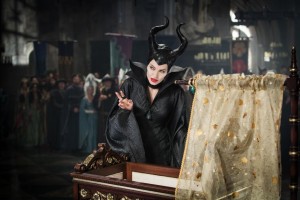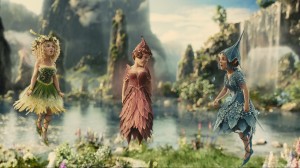
Disney’s Maleficent isn’t so much a spin-off of Sleeping Beauty as it is a retelling of the story from the perspective of the antagonist (who, as it turns out, isn’t really as bad as she seems). One can appreciate the efforts made to revise the fairy tale with a more updated and empowering version of its characters. Still, nothing can compensate for the fact that the final product is a strangely cold and choppy effort that fails to entertain.
 In this latest adaptation, the world is split – there’s a land of nasty humans and a magical realm populated by fantasy creatures. Maleficent (Angelina Jolie) is a kindly fairy who only wants to protect her world from invaders. However, her personality becomes vindictive after she is tricked and wounded by Stefan (Sharlto Copley), a young human whom she loves. After Stefan is named King, the vengeful Maleficent foists a curse upon his daughter Aurora (Elle Fanning) that will put the child to eternal sleep upon her 16th birthday.
In this latest adaptation, the world is split – there’s a land of nasty humans and a magical realm populated by fantasy creatures. Maleficent (Angelina Jolie) is a kindly fairy who only wants to protect her world from invaders. However, her personality becomes vindictive after she is tricked and wounded by Stefan (Sharlto Copley), a young human whom she loves. After Stefan is named King, the vengeful Maleficent foists a curse upon his daughter Aurora (Elle Fanning) that will put the child to eternal sleep upon her 16th birthday.
It’s a beautiful-looking movie with many impressive environments in both worlds as well as some slick (if at times overused) visual effects. And as expected, Jolie is perfectly cast and appears to enjoy digging her teeth into the character’s nastier side. When she’s angry, she has a commanding screen presence. Unfortunately, those moments are all too brief. For the majority of the movie, Maleficent finds herself falling under the charms of the princess, smiling wistfully as the young girl plays with the forest creatures.
Oddly enough, the movie is heavily edited with narration often filling in story points. It feels choppy (almost as if larger portions of the film were removed) and the characters aren’t developed in more than general points. In fact, it becomes difficult to relate to their plights. For the most part, this is a story where Maleficent isn’t angry but instead tortured by sadness and regret for her actions, King Stefan is a growling madman, and young princess Aurora is a bit of a space cadet dancing in the trees.
Yes, the motivation for Maleficent’s behavior is clear enough, but Stefan is confounding. His role seems to have been cut down significantly. As time passes, he becomes borderline psychotic with little explanation given for the change. Additionally, Aurora is given very little to do. If one was going through the trouble of updating the story, it would have been wise to make the girl a far more pro-active character than she appears here. It all leads to a rushed climax with little tension or drama.
 While some of the large, computer-generated environments are a wonder to behold, a lot of the fairy-world characters leave something to be desired. The film’s “comic relief” comes in the form of three goofy but troubling pixies. Their slapstick acts manage to be both grating and disturbing because of their creepy appearance. There’s nothing wrong with the cast members playing them, but the performer’s heads are shrunk and animated in a manner that is less than appealing to the eye.
While some of the large, computer-generated environments are a wonder to behold, a lot of the fairy-world characters leave something to be desired. The film’s “comic relief” comes in the form of three goofy but troubling pixies. Their slapstick acts manage to be both grating and disturbing because of their creepy appearance. There’s nothing wrong with the cast members playing them, but the performer’s heads are shrunk and animated in a manner that is less than appealing to the eye.
It’s difficult to revamp a classic and change important details while still attempting to hit many of the identical story beats. Frankly, this character might have been better off being given her own story in her own universe. Things may have been much clearer in the original screenplay, but the final version of Maleficent seems fractured, unfocused and unwilling to maximize the potential of its main character.


